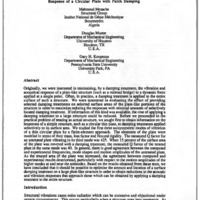-
Title
-
Response of a Circular Plate with Patch Damping
-
Report Number
-
WL-TR-91-3078 Volume III, p. HCC-1 thru HCC-13
-
Creator
-
Mezache, Mahmoud
-
Muster, Douglas
-
Koopman, Gary H.
-
Corporate Author
-
Structural Group, Institut National de Genie Mechanique, Bounnerdes, Algeria
-
Department of Mechanical Engineering, University of Houston
-
Department of Mechanical Engineering, Pennsylvania State University
-
Date
-
1991
-
Date Issued
-
1991-08
-
Extent
-
13
-
Identifier
-
ADA241313
-
Format
-
1 online resource
-
Abstract
-
Originally, we were interested in minimizing, by a damping treatment, the vibration and acoustical response of a plate-like structure (such as a railroad bridge) to a dynamic force applied at a single point. Often, in practice, a damping treatment is applied to the entire surface of such a structure. We were interested in evaluating the effect of providing selected damping treatments on selected surface areas of the plate-like portions of the structure in order to maximize reducing the responses with minimal amounts of selectively located damping treatment. If infonnation of this kind was available, the cost of applying a damping treatment to a large structure could be reduced. Before we proceeded to the practical problem of treating an actual structure, we sought first to obtain infonnation on the responses of a simple structure, such as a circular thin plate, to damping treatments applied selectively to its surface area. We studied the first three axisymmetric modes of vibration of a thin circular plate by a finite-element approach. The elements of the plate were modeled in terms of their mass, loss factor and flexural rigidity. The measured Q factor for an untreated plate vibrating in its third mode was 425. When 15 percent of the surface area of the plate was covered with a damping treatment, the measured Q factor of the treated plate in the same mode was 40. In general, there is good agreement between the computed and experimental frequencies, mode shapes and motion amplitudes of the untreated plate. As the treated area of the plate was increased, the agreement between computed and experimental results deteriorated, particularly with respect_to the motion amplitudes of the
higher modes at and near the antinodes. Based on the results obtained from these tests, we have concluded that it should be possible to optimize the amount and location of a surface damping treatment on a large plate-like structure in order to obtain reductions in the acoustic
and vibration responses that approach those which can be obtained by applying a damping treatment to the entire structure.
-
Description
-
Originally, we were interested in minimizing, by a damping treatment, the vibration and acoustical response of a plate-like structure (such as a railroad bridge) to a dynamic force applied at a single point. Often, in practice, a damping treatment is applied to the entire surface of such a structure. We were interested in evaluating the effect of providing selected damping treatments on selected surface areas of the plate-like portions of the
structure in order to maximize reducing the responses with minimal amounts of selectively located damping treatment. If infonnation of this kind was available, the cost of applying a damping treatment to a large structure could be reduced. Before we proceeded to the practical problem of treating an actual structure, we sought first to obtain infonnation on the responses of a simple structure, such as a circular thin plate, to damping treatments applied selectively to its surface area. We studied the first three axisymmetric modes of vibration of a thin circular plate by a finite-element approach. The elements of the plate were modeled in terms of their mass, loss factor and flexural rigidity. The measured Q factor for an untreated plate vibrating in its third mode was 425. When 15 percent of the surface area of the plate was covered with a damping treatment, the measured Q factor of the treated plate in the same mode was 40. In general, there is good agreement between the computed and experimental frequencies, mode shapes and motion amplitudes of the untreated plate. As the treated area of the plate was increased, the agreement between computed and experimental results deteriorated, particularly with respect_to the motion amplitudes of the
higher modes at and near the antinodes. Based on the results obtained from these tests, we have concluded that it should be possible to optimize the amount and location of a surface damping treatment on a large plate-like structure in order to obtain reductions in the acoustic
and vibration responses that approach those which can be obtained by applying a damping treatment to the entire structure.
-
Distribution Classification
-
1
-
Distribution Conflict
-
No
-
DTIC Record Exists
-
No
-
Illinois Tech Related
-
No
-
Photo Quality
-
Not Needed
-
Report Availability
-
Full text available
-
Type
-
article
 articleHCC
articleHCC